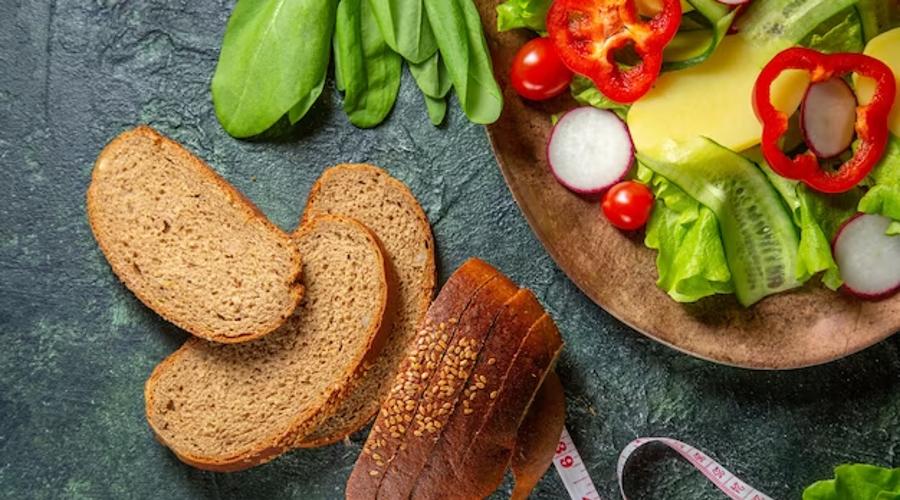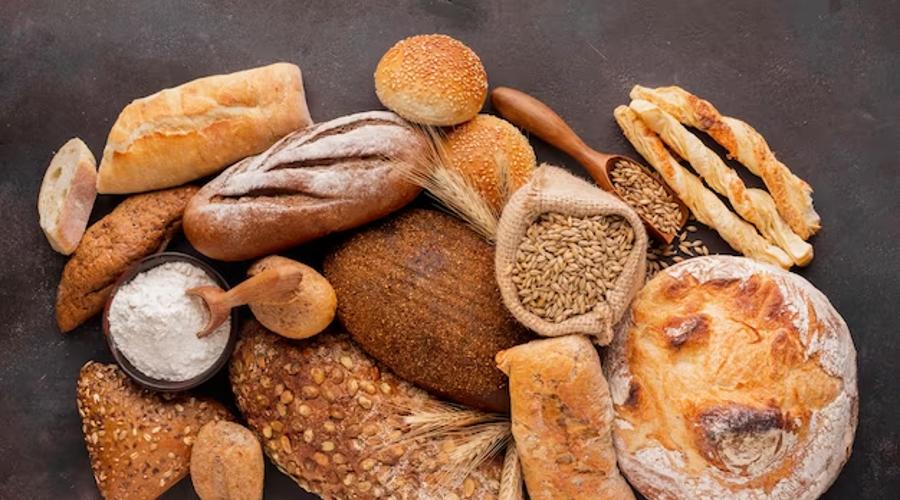Are you searching for a healthy and delicious addition to your Mediterranean diet? Look no further! In today’s blog post, we’re diving into the world of Mediterranean diet bread recipes, where centuries-old traditions meet modern culinary delights.
Bread has been a staple in Mediterranean cuisine for generations, and its versatility and health benefits make it a perfect choice for those seeking a wholesome and balanced diet. Join us as we explore the secrets behind crafting delectable, nutrient-rich bread that will transport your taste buds to the sun-kissed shores of the Mediterranean. From rustic olive loaves to aromatic herb-infused flatbreads, get ready to elevate your baking game while nourishing your body and delighting your senses

Health Benefits of Mediterranean Diet Bread
After introducing the health benefits of incorporating Mediterranean diet bread into one’s lifestyle, we can dive deeper into the specific advantages.
High in Nutrients and Fiber
Mediterranean diet bread is a nutritional powerhouse, packed with essential nutrients and dietary fiber. This wholesome bread is typically made from whole grain flours, which retain the natural goodness of the entire grain. Whole grains provide a rich source of vitamins, minerals, and antioxidants that contribute to overall well-being.
Additionally, the high fiber content in Mediterranean diet bread promotes healthy digestion, helps regulate blood sugar levels, and supports weight management. Including Mediterranean bread in your diet can help you meet your daily fiber requirements and maintain a healthy digestive system.
List of fiber-rich ingredients commonly used in Mediterranean bread:
- Whole wheat flour
- Oats
- Barley
- Flaxseeds
- Chia seeds
Supports Heart Health
The Mediterranean diet is renowned for its heart-healthy benefits, and bread plays a significant role in this aspect. Mediterranean diet bread recipes often incorporate heart-healthy ingredients such as olive oil and nuts. Olive oil, a staple in Mediterranean cuisine, is rich in monounsaturated fats, which can help reduce bad cholesterol levels and lower the risk of heart disease.
Nuts, another common ingredient, provide a good source of unsaturated fats, fiber, and plant sterols, all of which contribute to a healthy heart. By including Mediterranean bread in your diet, you can enjoy the benefits of these heart-protective ingredients.
List of heart-healthy ingredients commonly used in Mediterranean bread:
- Olive oil
- Almonds
- Walnuts
- Hazelnuts
- Pistachios
Promotes Weight Management
Mediterranean diet bread can be a valuable ally in maintaining a healthy weight. The combination of whole grains, fiber, and nutritious ingredients provides a satisfying and nourishing option that keeps you feeling fuller for longer.
The fiber content in Mediterranean bread helps control appetite, reduces overeating, and aids in weight management. Additionally, the inclusion of wholesome ingredients and the absence of processed additives make Mediterranean bread a healthier alternative to many commercial bread options. By incorporating Mediterranean bread into your diet, you can enjoy a satisfying and delicious addition while supporting your weight management goals.
List of Mediterranean bread varieties that can aid in weight management:
- Whole wheat pita bread
- Multigrain bread
- Seeded bread
- Bran bread
- Rye bread

Traditional Mediterranean Bread Varieties
Traditional Mediterranean bread varieties offer a glimpse into the rich culinary heritage of the region. From the aromatic Focaccia of Italy to the versatile Greek Pita Bread and the sesame-coated Turkish Simit, each bread has its own unique characteristics and flavors that contribute to the diverse Mediterranean diet. Let’s explore these traditional bread varieties in detail:
Focaccia: A Taste of Italy
Focaccia is an iconic Italian bread known for its pillowy texture and delightful toppings. This beloved bread, often associated with Liguria and Genoa, has gained popularity worldwide. The secret to its flavor lies in the generous drizzle of extra virgin olive oil and the medley of herbs and seasonings.
Focaccia can be enjoyed as a standalone snack, as a side dish, or as a base for sandwiches and bruschetta. Its versatility and Mediterranean flavors make it a perfect choice for those following a Mediterranean diet.
List of popular Focaccia toppings and seasonings:
- Fresh rosemary
- Sea salt
- Cherry tomatoes
- Olives
- Caramelized onions
Greek Pita Bread: Versatility on Your Plate
Greek Pita Bread is a staple in Mediterranean cuisine, known for its versatility and ability to accompany a wide range of dishes. This round, pocketed bread is perfect for stuffing with flavorful fillings or dipping into dips and spreads.
Pita bread can be enjoyed as a side with Mediterranean-style grilled meats, used to make gyros or souvlaki wraps, or torn into pieces for scooping up hummus or tzatziki. Its soft and slightly chewy texture, along with its ability to hold a variety of ingredients, makes Greek Pita Bread an essential component of the Mediterranean diet.
List of dishes and uses for Greek Pita Bread:
- Souvlaki wraps
- Gyros
- Falafel sandwiches
- Greek salad pita pockets
- Dipping into tzatziki or baba ganoush
Turkish Simit: Sesame-Coated Delicacy
Turkish Simit is a beloved bread in Turkey, known for its ring-shaped form and distinctive sesame coating. This crunchy and chewy bread is commonly enjoyed for breakfast or as a snack throughout the day.
Simit is often paired with Turkish tea and various spreads or enjoyed on its own. Its unique texture, combined with the nutty flavor of sesame seeds, creates a delightful taste experience. Including Turkish Simit in your Mediterranean diet adds a touch of Turkish culinary tradition to your bread selection.
List of common ways to enjoy Turkish Simit:
- Pairing with Turkish tea
- Spreading with cream cheese or Nutella
- Accompanying savory dips like muhammara or hummus
- Enjoying plain as a satisfying snack
- Savoring with traditional Turkish breakfast ingredients like olives, feta cheese, and tomatoes

Modern Mediterranean Bread Twists
Incorporating modern twists into traditional Mediterranean bread recipes has given rise to delightful variations that infuse new flavors and ingredients into the diet. These innovative breads offer a fusion of Mediterranean essence and contemporary culinary techniques.
Let’s explore three examples of modern Mediterranean bread twists that are sure to tantalize your taste buds.
Sundried Tomato and Basil Bread: Bursting with Mediterranean Flavors
Sundried Tomato and Basil Bread is a delightful creation that brings together the vibrant flavors of the Mediterranean. The tangy sweetness of sundried tomatoes and the aromatic essence of fresh basil infuse the bread with bursts of Mediterranean goodness. Each slice is a harmonious combination of savory and herbaceous notes.
This bread is perfect for enjoying on its own, slathered with olive tapenade, or used as a base for flavorful sandwiches. The recipe for this Mediterranean-inspired bread is simple yet yields a loaf that is sure to impress.
List of ingredients for Sundried Tomato and Basil Bread:
- All-purpose flour
- Whole wheat flour
- Active dry yeast
- Warm water
- Olive oil
- Sundried tomatoes (chopped)
- Fresh basil leaves (chopped)
Olive and Rosemary Focaccia: Aromatic and Savory Delight
Olive and Rosemary Focaccia is a sensory delight that captures the essence of the Mediterranean. This aromatic bread is infused with the flavors of briny olives and fragrant rosemary, creating a savory experience with every bite.
The soft and pillowy texture of the focaccia, coupled with the burst of flavors from the olives and the herbal notes of rosemary, makes it a versatile addition to any Mediterranean-inspired meal. Serve it as an appetizer, use it as a base for gourmet sandwiches, or enjoy it alongside a bowl of hearty soup.
List of ingredients for Olive and Rosemary Focaccia:
- Bread flour
- Active dry yeast
- Warm water
- Olive oil
- Kalamata olives (pitted and halved)
- Fresh rosemary leaves (chopped)
Whole Wheat Greek Flatbread: Nutty and Wholesome Indulgence
Whole Wheat Greek Flatbread is a nutty and wholesome twist on traditional flatbread recipes. Made with whole wheat flour, this bread not only adds a rustic and hearty element to your meals but also aligns perfectly with the health-conscious principles of the Mediterranean diet.
The nutty flavor and slightly denser texture of the flatbread add depth to its versatility. It can be used as a wrap for grilled vegetables and protein, as a base for homemade pizzas, or simply enjoyed on its own with a side of tzatziki.
List of ingredients for Whole Wheat Greek Flatbread:
- Whole wheat flour
- All-purpose flour
- Active dry yeast
- Warm water
- Olive oil
- Salt

Baking Tips and Techniques for Mediterranean Bread
Mastering the art of baking Mediterranean bread involves understanding the crucial tips and techniques that contribute to achieving the authentic texture, enhanced flavors, and perfect results. Let’s delve into three key aspects that will elevate your Mediterranean bread recipes.
Choosing the Right Flour Blend for Authentic Texture
Selecting the appropriate flour blend is paramount in creating Mediterranean bread with an authentic texture. While all-purpose flour is commonly used, incorporating specific types of flour can enhance the authenticity of the bread.
A blend of all-purpose flour and whole wheat flour or alternative grain flours, such as spelt or einkorn, can provide a nuttier flavor and heartier texture. Experimenting with different flour combinations will help you achieve the desired outcome for your Mediterranean bread recipes.
List of commonly used flours in Mediterranean bread recipes:
- All-purpose flour
- Whole wheat flour
- Spelt flour
- Einkorn flour
- Barley flour
Incorporating Mediterranean Ingredients for Enhanced Flavor
Infusing your Mediterranean bread recipes with authentic ingredients will elevate their flavors to new heights. Experiment with incorporating Mediterranean staples such as olive oil, herbs, and spices into your dough. Extra virgin olive oil not only adds a distinct flavor but also contributes to the moistness of the bread.
Fresh or dried herbs like rosemary, thyme, oregano, and basil can infuse the bread with aromatic notes. Don’t shy away from exploring regional flavors by adding ingredients like sun-dried tomatoes, feta cheese, or Kalamata olives to your bread for a truly Mediterranean experience.
List of Mediterranean ingredients to enhance the flavor of your bread:
- Extra virgin olive oil
- Fresh or dried herbs (rosemary, thyme, oregano, basil)
- Sun-dried tomatoes
- Feta cheese
- Kalamata olives
Proper Kneading and Proofing Techniques for Perfect Results
Mastering the art of kneading and proofing is vital for achieving the perfect texture and rise in your Mediterranean bread. Kneading develops gluten strands, giving the bread structure and elasticity. Take your time and knead the dough until it becomes smooth and elastic.
Proofing allows the dough to rise and develop flavor. Find a warm, draft-free spot for proofing and ensure that the dough has doubled in size before shaping and baking. These techniques require patience and practice, but they are essential for achieving the ideal texture and crumb in your Mediterranean bread.
List of tips for proper kneading and proofing techniques:
- Knead the dough until it becomes smooth and elastic.
- Allow the dough to rise in a warm, draft-free environment.
- Cover the dough with a damp cloth or plastic wrap to retain moisture.
- Monitor the dough closely to ensure it has doubled in size before proceeding.
- Gently punch down the risen dough to release excess air before shaping.

Serving and Pairing Suggestions
When it comes to enjoying your freshly baked Mediterranean bread, the right pairings can elevate your culinary experience to new heights. Let’s explore three delightful suggestions that will enhance the flavors and complement your Mediterranean bread recipes.
Mediterranean-Inspired Dips and Spreads to Accompany Bread
Mediterranean bread is a perfect canvas for a variety of dips and spreads that showcase the vibrant flavors of the region. From creamy hummus to tangy tzatziki, these Mediterranean-inspired accompaniments add a burst of flavor and texture to your bread.
They provide a delightful contrast and create a harmonious balance when paired together. Whether you’re serving your bread as an appetizer, a snack, or a side dish, these dips and spreads are an ideal choice.
List of Mediterranean-inspired dips and spreads to accompany bread:
- Classic hummus made with chickpeas, tahini, lemon juice, and garlic
- Creamy baba ganoush with roasted eggplant, tahini, and aromatic spices
- Refreshing tzatziki made with Greek yogurt, cucumber, garlic, and dill
- Spicy muhammara with roasted red peppers, walnuts, and pomegranate molasses
- Flavorsome tapenade made with olives, capers, garlic, and olive oil
Complementing Bread with Fresh Salads and Savory Meats
To create a complete Mediterranean meal, consider pairing your bread with fresh salads and savory meats. The vibrant flavors and textures of Mediterranean salads, combined with the heartiness of meats, create a satisfying and well-rounded dining experience.
Salads featuring ripe tomatoes, crisp cucumbers, briny olives, and tangy feta cheese can be enjoyed alongside your bread, while savory grilled meats, such as marinated chicken or lamb, add depth and richness to the meal.
List of fresh salads and savory meats to complement your bread:
- Classic Greek salad with tomatoes, cucumbers, red onions, Kalamata olives, and feta cheese
- Tabbouleh, a refreshing Lebanese salad made with bulgur wheat, parsley, tomatoes, and lemon dressing
- Grilled chicken or lamb marinated with Mediterranean spices, such as oregano, garlic, and lemon juice
- Mediterranean-style kebabs with skewered vegetables and marinated meats
- Oven-roasted vegetables, such as eggplant, zucchini, and bell peppers, with herbs and olive oil
Wine and Cheese Pairings to Elevate Your Bread Experience
To indulge in the full spectrum of flavors, consider pairing your Mediterranean bread with fine wines and artisanal cheeses. The right combination can enhance the taste profiles and create a sensory experience that delights the palate. The Mediterranean region offers a rich selection of wines and cheeses that beautifully complement the bread’s flavors. Whether you prefer a bold red wine with robust cheese or a crisp white wine with creamy goat cheese, the possibilities are endless.
Pairing Mediterranean bread with a robust red wine, such as Chianti or Rioja, alongside aged cheeses like Parmigiano-Reggiano or Pecorino Romano.
Pairing Mediterranean bread with a crisp white wine, such as Sauvignon Blanc or Assyrtiko, alongside tangy and creamy cheeses like feta or goat cheese.
Pairing Mediterranean bread with a rosé wine, such as Provence Rosé, alongside soft and mild cheeses like Brie or Camembert.
Pairing Mediterranean bread with a sparkling wine, such as Prosecco or Cava, alongside fresh
FAQ:
Can I substitute all-purpose flour with whole wheat flour in my Mediterranean bread recipe?
Absolutely! Whole wheat flour can be substituted for all or part of the all-purpose flour in your Mediterranean bread recipe. It will add a nuttier flavor and a heartier texture to your bread, while also providing the nutritional benefits of whole grains. Experiment with different ratios to find the balance that suits your taste preferences.
Can I make Mediterranean bread without yeast?
Yes, you can make Mediterranean bread without yeast by using alternative leavening agents such as baking powder or baking soda. Keep in mind that the texture and flavor of the bread may differ from traditional yeast-based recipes. Look for specific recipes that are designed to be yeast-free or explore flatbread variations that rely on other leavening agents.
Can I freeze Mediterranean bread for later use?
Yes, Mediterranean bread can be successfully frozen for later use. Ensure that the bread has cooled completely before wrapping it tightly in plastic wrap or placing it in an airtight container. Label and date the package, and store it in the freezer for up to three months. When ready to enjoy, thaw the bread at room temperature or reheat it in the oven to revive its freshness.
How can I store Mediterranean bread to keep it fresh?
To keep your Mediterranean bread fresh, store it in a paper bag or bread box at room temperature for up to two days. Avoid storing it in the refrigerator, as it can dry out the bread. If you anticipate not consuming the bread within a couple of days, consider freezing it as mentioned in the previous question.
Can I customize my Mediterranean bread recipe with additional ingredients?
Absolutely! One of the wonderful aspects of baking Mediterranean bread is the ability to customize it with various ingredients. Experiment with adding sun-dried tomatoes, olives, herbs, seeds, or even cheeses to your dough for unique flavor profiles. Just ensure that the additional ingredients are compatible with the overall texture and rise of the bread.

